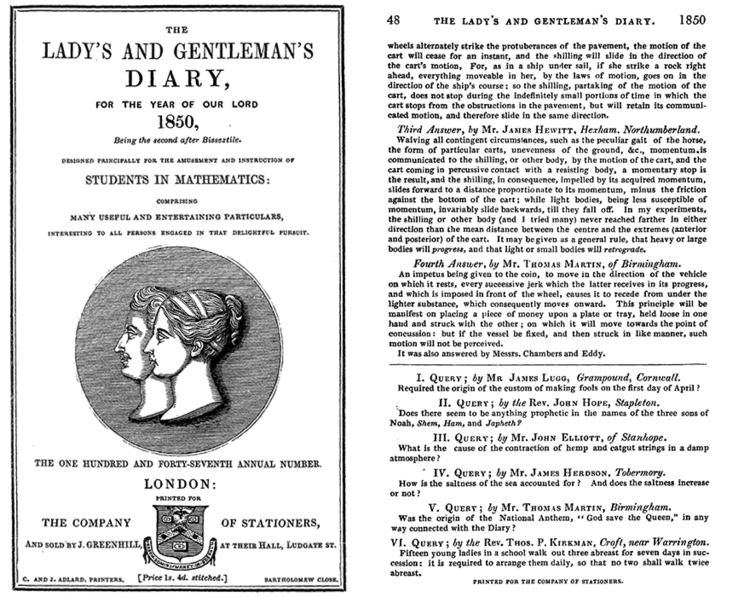 | ||
Kirkman's schoolgirl problem is a problem in combinatorics proposed by Rev. Thomas Penyngton Kirkman in 1850 as Query VI in The Lady's and Gentleman's Diary (pg.48). The problem states:
Contents
Fifteen young ladies in a school walk out three abreast for seven days in succession: it is required to arrange them daily so that no two shall walk twice abreast.
Solution
If the girls are numbered from 01 to 15, the following arrangement is one solution:
A solution to this problem is an example of a Kirkman triple system, which is a Steiner triple system having a parallelism, that is, a partition of the blocks of the triple system into parallel classes which are themselves partitions of the points into disjoint blocks.
There are seven non-isomorphic solutions to the schoolgirl problem. Two of these can be visualized as relations between a tetrahedron and its vertices, edges, and faces. An approach using projective geometry of three dimensions over GF(2) is given below.
History
The first solution was published by Arthur Cayley. This was shortly followed by Kirkman's own solution which was given as a special case of his considerations on combinatorial arrangements published three years prior. J. J. Sylvester also investigated the problem and ended up declaring that Kirkman stole the idea from him. The puzzle appeared in several recreational mathematics books at the turn of the century by Lucas, Rouse Ball, Ahrens, and Dudeney.
Kirkman often complained about the fact that his substantial paper (Kirkman 1847) was totally eclipsed by the popular interest in the schoolgirl problem.
Galois geometry
In 1910 the problem was addressed using Galois geometry by George Conwell
The Galois field GF(2) with two elements is used with four homogeneous coordinates to form PG(3,2) which has 15 points, 3 points to a line, 7 points and 7 lines in a plane. A plane can be considered a complete quadrilateral together with the line through its diagonal points. Each point is on 7 lines, and there are 35 lines in all.
The lines of PG(3,2) are identified by their Plücker coordinates in PG(5,2) with 63 points, 35 of which represent lines of PG(3,2). These 35 points form the surface S known as the Klein quadric. For each of the 28 points off S there are 6 lines through it which do not intersect S.
As there are seven days in a week, the heptad is an important part of the solution:
When two points as A and B of the line ABC are chosen, each of the five other lines through A is met by only one of the five other lines through B. The five points determined by the intersections of these pairs of lines, together with the two points A and B we designate a "heptad".A heptad is determined by any two of its points. Each of the 28 points off S lies in two heptads. There are 8 heptads. The projective linear group PGL(3,2) is isomorphic the alternating group on the 8 heptads.
The schoolgirl problem consists in finding seven lines in the 5-space which do not intersect and such that any two lines always have a heptad in common.
Spreads and packing
A partition of points into lines is called a spread, and the partition of the spreads of a geometry is called a packing. When Hirschfeld considered the problem in his Finite Projective Spaces of Three Dimensions(1985), he noted that a solution corresponds to a packing of PG(3,2), essentially as described by Conwell above.
Generalization
The problem can be generalized to
Many variations of the basic problem can be considered. Alan Hartman solves a problem of this type with the requirement that no trio walks in a row of four more than once using Steiner quadruple systems.
More recently a similar problem known as the Social Golfer Problem has gained interest that deals with 20 golfers who want to get to play with different people each day in groups of 4.
As this is a regrouping strategy where all groups are orthogonal, this process within the problem of organising a large group into smaller groups where no two people share the same group twice can be referred to as orthogonal regrouping. However, this term is currently not commonly used and evidence suggests that there isn't a common name for the process.
